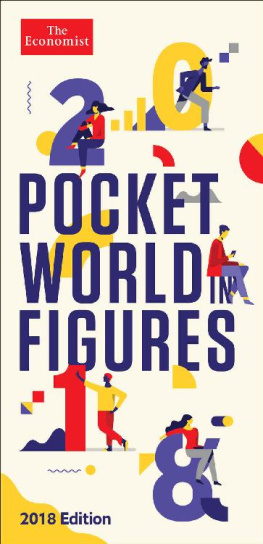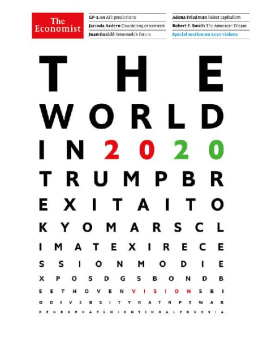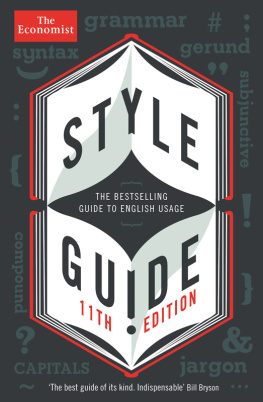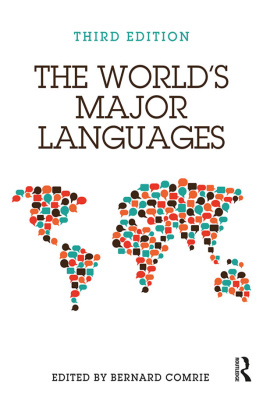The
Economist
POCKET
WORLD IN
FIGURES
2018 Edition
Published by
Profile Books Ltd
3 Holford Yard
Bevin Way
London WC1X 9HD
Published under exclusive licence from The Economist by Profile Books, 2017
Copyright The Economist Newspaper Ltd, 1991, 1992, 1993, 1994, 1995, 1996, 1997, 1998, 1999, 2000, 2001, 2002, 2003, 2004, 2005, 2006, 2007, 2008, 2009, 2010, 2011, 2012, 2013, 2014, 2015, 2016, 2017
Material researched by
Andrea Burgess, Lisa Davies, Graham Douglas, Mark Doyle, Ian Emery, Conrad Heine, Carol Howard, David McKelvey, Georgina McKelvey, Guy Scriven, Christopher Wilson
All rights reserved. Without limiting the rights under copyright reserved above, no part of this publication may be reproduced, stored in or introduced into a retrieval system, or transmitted, in any form or by any means (electronic, mechanical, photocopying, recording or otherwise), without the prior written permission of both the copyright owner and the above publisher of this book.
The greatest care has been taken in compiling this book. However, no responsibility can be accepted by the publishers or compilers for the accuracy of the information presented.
A CIP catalogue record for this book is available from the British Library
eISBN 978 1 78283 305 5
Contents
Geography and demographics
Economics
Business
Politics and society
Health and welfare
Culture and entertainment
Introduction
This 2018 edition of The Economist Pocket World in Figures presents and analyses data about the world in two sections:
The world rankings consider and rank the performance of 185 countries against a range of indicators in six sections: geography and demographics, economics, business, politics and society, health and welfare, and culture and entertainment. The countries included are those which had (in 2015) a population of at least 1m or a GDP of at least $3bn; they are listed on pages 25053. New rankings this year include topics as diverse as the average number of births, biggest destination countries for migrants, largest merchant fleets by flags of convenience, terrorist attacks, dams, reservoirs and countries with most urban population living in slums. Some of the rankings data are shown as charts and graphs.
The country profiles look in detail at 64 major countries, listed on page 109, plus profiles of the euro area and the world.
Test your Pocket World in Figures knowledge with our World Rankings Quiz on pages 2427. Answers can be found in the corresponding world rankings section.
Notes
The extent and quality of the statistics available vary from country to country. Every care has been taken to specify the broad definitions on which the data are based and to indicate cases where data quality or technical difficulties are such that interpretation of the figures is likely to be seriously affected. Nevertheless, figures from individual countries may differ from standard international statistical definitions. The term "country" can also refer to territories or economic entities.
Definitions of the statistics shown are given on the relevant page or in the glossary on pages 2489. Figures may not add exactly to totals, or percentages to 100, because of rounding or, in the case of GDP, statistical adjustment. Sums of money have generally been converted to US dollars at the official exchange rate ruling at the time to which the figures refer.
Some country definitions
Macedonia is officially known as the Former Yugoslav Republic of Macedonia. Data for Cyprus normally refer to Greek Cyprus only. Data for China do not include Hong Kong or Macau. For countries such as Morocco they exclude disputed areas. Congo-Kinshasa refers to the Democratic Republic of Congo, formerly known as Zaire. Congo-Brazzaville refers to the other Congo. Euro area data normally refer to the 19 members that had adopted the euro as at December 31 2016: Austria, Belgium, Cyprus, Estonia, Finland, France, Germany, Greece, Ireland, Italy, Latvia, Lithuania, Luxembourg, Malta, Netherlands, Portugal, Slovakia, Slovenia and Spain. Euro area (18) excludes Lithuania, which adopted the euro on January 1 2015. Euro area (15) refers to the 15 countries in the euro area that are members of the OECD. Data referring to the European Union include the UK, which in June 2016 voted in a referendum to leave the EU. Negotiations over the country's departure will take some time. For more information about the EU, euro area and OECD see the glossary on pages 2489.
Statistical basis
The all-important factor in a book of this kind is to be able to make reliable comparisons between countries. Although this is never quite possible for the reasons stated above, the best route, which this book takes, is to compare data for the same year or period and to use actual, not estimated, figures wherever possible. In some cases, only OECD members are considered. Where a country's data are excessively out of date, they are excluded. The research for this edition was carried out in 2017 using the latest available sources that present data on an internationally comparable basis.
Data in the country profiles, unless otherwise indicated, refer to the year ending December 31 2015. Life expectancy, crude birth, death and fertility rates are based on 201520 estimated averages; energy data are for 2014 and religion data for 2010; marriage and divorce, employment, health and education, consumer goods and services data refer to the latest year for which figures are available.
Other definitions
Data shown in country profiles may not always be consistent with those shown in the world rankings because the definitions or years covered can differ.
Statistics for principal exports and principal imports are normally based on customs statistics. These are generally compiled on different definitions to the visible exports and imports figures shown in the balance of payments section.
Energy-consumption data are not always reliable, particularly for the major oil-producing countries; consumption per person data may therefore be higher than in reality. Energy exports can exceed production and imports can exceed consumption if transit operations distort trade data or oil is imported for refining and re-exported.
Abbreviations and conventions
(see also glossary on pages 2489)
bn | billion (one thousand million) |
EU | European Union |
GDP | gross domestic product |
GNI | gross national income |
ha | hectare |
kg | kilogram |
km | kilometre |
m | million |
PPP | purchasing power parity |
TOE | tonnes of oil equivalent |
trn | trillion (one thousand billion) |
... | not available |
World
rankings
Countries: natural facts
Countries: the largest
000 sq km
Next page







